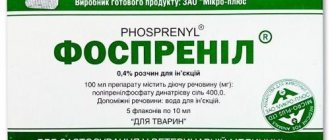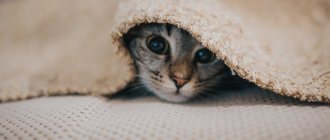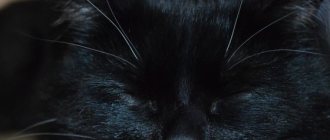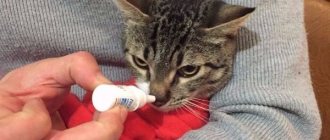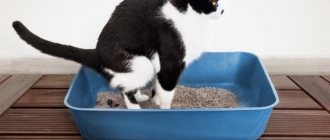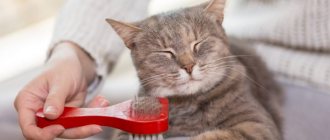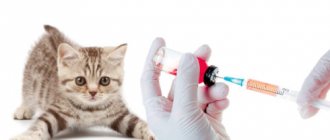Causes
Owners are advised to pay attention to accompanying symptoms in cats, such as refusal to eat, redness in the ear, and fever.
These signs will help determine the cause of the unpleasant odor, which may include the following:
- Allergic reactions . In a cat prone to allergies, inflammation of the ear canal manifests itself as a reaction to an irritant. In addition to discharge from the ears, itching and pain appear.
- Otitis . When the cat is sick, the ear hurts and the secretion of wax increases. The animal often shakes its head and itches. The disease, if left untreated, often leads to hearing loss.
- Trauma . A blow to the head can cause inflammation. Blood accumulates in the ear canal and harmful microorganisms multiply, causing suppuration.
- Inflammation of the ears . Occurs due to water ingress. It is not recommended to frequently wash cats in the bathtub or water them with water. It is advisable to insert cotton swabs into the ears during the procedure to prevent shampoo and water from entering the ear canal.
- Ear mite . The disease is contagious and affects cats walking outside. When infected, the ears not only smell bad, but also have dark-colored discharge.
A veterinarian can make an accurate diagnosis based on a visual examination and tests. Self-medication leads to hearing loss, complications, and death of the pet.
Smells rotten
A putrid odor is a sign of an inflammatory process and appears due to the proliferation of bacteria in the ear canal.
Reasons why it smells rotten:
- ear mite;
- oncology.
If a rotten smell or dark discharge appears, it is recommended to contact a veterinarian. Timely diagnosis will help preserve the animal’s hearing.
Smells rotten
If the ear smells like rotten meat, it means the animal has suffered a head injury. Even a slight blow leads to serious consequences: blood accumulates in the ear, and the smell of rotten meat appears.
Discharge and unpleasant odor
Discharge indicates the presence of infection. They may be with pus or blood. Fungal diseases also cause unpleasant odor and discharge from the ears.
Only one ear smells
If your pet has odor from only one ear, this indicates that the infection has not spread. With timely treatment, the symptom will disappear and will not lead to consequences. Treatment is carried out on both ears.
Unpleasant odor from a kitten's ears
In young kittens, the causes of bad ear odor may be due to poor hygiene. Earwax accumulates, creating a favorable environment for bacteria.
Ear mites also cause a foul-smelling discharge in your kitten.
It is very important to keep your cat's ears clean from an early age . The infection in a kitten spreads faster and has a negative effect on the hearing system.
To increase the body's resistance to various infections, including ear infections, it is necessary to monitor the kitten's nutrition. Dairy products can cause an allergic reaction. Feed is selected according to the age and breed of the animal.
Why is this happening?
Normally, the microflora of the ear canal is stable and prevents the penetration and development of pathogenic microorganisms deep into the ear canal. Due to the disruption of the normal environment, the animal has many problems, some of which can result in complete deafness, or even death, of the cat.
Oddly enough, a very common cause of “odors” from cats’ ears is common allergies , especially food allergies. The latter is especially common in cats that are on a constant diet of dry food. Allergic reactions lead to disruption of the natural microflora, which, in turn, leads to the activation of pathogenic microflora. Particularly “vicious” are fungi and yeasts, which quickly grow on damaged skin, deprived of its natural protection. A characteristic sign of an advanced process is that the cat has a rotten smell from the ear.
Bacteria and yeast are especially dangerous if water regularly enters the ear canal . This is especially true for animals that, for some reason, have to be washed regularly. Fortunately, at least cats don't have long, floppy ears.
Diagnostics
When a stink appears from an animal's ear, it is recommended to begin the diagnosis with a visual examination. To see better, you can shine a flashlight into your ear.
What you should be wary of:
- strong smell of rot;
- smells like rotten meat;
- pus, black, brown discharge;
- blood, scabs;
- redness of the skin.
It is impossible to make an accurate diagnosis at home. For any alarming symptoms, contact a specialist.
Veterinarian actions:
- taking a blood test to identify the inflammatory process;
- examination using an otoscope;
- ear smear, bacteriological analysis of discharge;
- biopsy (used as a last resort).
If necessary and the disease is severe, the cat is left for treatment at a veterinary clinic. In milder cases, the doctor prescribes medications for home therapy .
How to identify ear mites:
- Discharge from the ears has a brown tint.
- The cat constantly shakes his ears and does not allow himself to be stroked.
- Body temperature rises, the animal becomes lethargic and restless.
- In the acute stage of the disease, touching the ears causes pain and tremors in the hind legs.
- Test: Use a cotton swab to take a small amount of discharge and shake it onto a black sheet of paper. If white moving dots appear, this is an ear mite.
Timely treatment prevents unpleasant consequences, hearing loss. The tick can cause inflammation of the brain, leading to death.
Prevention
Prevention of the disease consists of monthly examination of the ear canals and preventive removal of accumulated wax. According to the anatomical features of the structure of shells in Sphinxes, Siamese, and Orientals, they are treated weekly.
One of the reasons for the development of otitis media is an allergic response to food. Housewives who treat their pets with food that is unusual for cats, as well as those who abuse vitamin supplements, are to blame. An excess of biological catalysts is more harmful than hypovitaminosis. The optimal solution is to use premium professional feed.
Timely disinsection prevents the proliferation of ectoparasites, as well as ear mites. The latter are activated when the immune system is weakened, so timely vaccination will protect the cat from viral infections and arthropod parasites.
Bathing causes a lot of anxiety. The animal does not need water treatments, but cat owners think differently. To prevent liquid from getting into the ear canals, you need to insert cotton plugs before bathing, and do not forget to remove them after the procedure.
Regular ear cleaning prevents ear infections
Treatment
Therapy depends on the diagnosis. Treatment must be comprehensive and includes hygiene procedures, medications, diet, and is carried out in three stages:
- Cleaning the ear canals.
- Taking medications prescribed by a veterinarian.
- Strengthening the immune system.
Hygiene procedures begin with cleaning the ear canal. For this purpose, special lotions are used that have anti-inflammatory and antiseptic effects.
The product is dripped into the ear and lightly massaged. Contaminants come out with excess liquid. Then gently wipe the skin with a cotton pad.
At this moment, the cat may shake its head and twitch its ear - this is a normal reaction. In this way, he gets rid of the fluid that bothers him, and the auricle is cleansed.
Medications
Drops are used to treat otitis media. They have antibacterial, anti-inflammatory and analgesic effects.
Associated symptoms
The animal may often rub the outer part of the auditory organ with its paw.
In addition to the fact that the cat’s ears begin to stink, the owner of a pet may notice the following undesirable symptoms:
- rubbing the auditory organs with a paw;
- redness of the inside of the ear;
- loss of appetite;
- general increase in body temperature;
- apathy or irritability;
- constant meowing;
- rashes on the skin.
What to do to get rid of an unpleasant odor?
The first thing to do if your cat has smelly ears (of course, in the absence of obvious inflammation and severe pain in the area) is to clean the ear canal of excess secretions. For this purpose, a large number of hygiene lotions are sold, often with the addition of light anti-inflammatory and antiseptic components.
The lotion (you shouldn’t skimp, it’s better to pour in more liquid, at least half a milliliter) is dropped into the cat’s ear, after which the base of the auricle is massaged, and thus the solution is distributed throughout the entire ear canal.
After this, excess fluid along with impurities are removed from the ear canal naturally; the person only needs to wipe the inside of the auricle with a cotton swab. You can repeat the procedure several times - let the cat shake its head for a while and thus get rid of everything unnecessary.
After cleansing, you can begin instilling medicinal drops if prescribed by your doctor. Sometimes systemic treatment with tablets or injections is required, for example, for severe bacterial infections. In rare cases, for example, with neoplasms or severe narrowing of the auditory canal, surgery may be required.
And yet, most often the cause of unpleasant odor from the ears is excessive secretion of ear fat. In this case, it will be enough to periodically perform hygiene procedures to maintain the cleanliness and health of the auditory canal.
Prevention of ear diseases in cats
Some congenital deformities of the auricle are purposefully fixed by felinologists.
Scottish fold kitten
The folded ear mutation has appeared repeatedly in cat populations. On its basis, the Scottish Fold breed was created.
American Curl cat
The “twisted ear” mutation is dominant and, unlike the previous one, is harmless. Having fixed this mutation, the American Curl breed was created.
The de novo mutation was first discovered in Moscow and was named “fold.” In such cats, the pinna is not only shortened, but also completely covered with folds, giving it a corrugated appearance. Inheritance is not precisely established, but is determined by the recessive allele.
Injuries
Damage to the ear most often occurs as self-injury when scratching or during fights with other cats. The reason for scratching is otitis externa. Local treatment of the outer ear is unsuccessful until the causes of otitis media are eliminated. Shaking your head during intense itching can cause a hematoma to form, where blood from ruptured blood vessels fills the cavity between the skin and cartilage.
Hematoma of the auricle
Hematoma is treated surgically.
Dermatoses
Dermatosis includes a group of skin lesions. He can be:
- allergic,
- flea,
- caused by scabies mites - notoedrosis,
- caused by subcutaneous mites - demodicosis.
For quality treatment of dermatosis, an accurate diagnosis of its cause is necessary.
Dermatosis of the auricle caused by notoedrosis
Diagnostic methods
When making a diagnosis, the veterinarian examines the animal's ears using an otoscope. If a tick infestation is suspected, a scraping of dark plaque is taken and examined under a microscope. Other diagnostic methods are also used:
- collection of secretions for bacteriological analysis;
- testing for allergic reactions;
- blood test to determine the general condition of the cat’s body;
- cytological examination of the contents of the auricle.
Preventive actions
To prevent an unpleasant aroma from a cat’s ears, it is important for the pet owner to systematically examine his hearing organs. At least once a week you will need to clean your ears using special liquids and cotton swabs. The cat's owner also needs to ensure that she does not spend time in drafts. When bathing, it is recommended to insert cotton balls into your pet's ear to prevent water from getting into them.
After the bath, the animal should be in a warm room. If necessary, the cat can be carefully dried with a hairdryer. An important preventive measure is diet control. If the owner prefers to give the cat ready-made industrial food, it is imperative to take into account its composition and expiration date. When choosing complementary foods, you need to pay attention to the gender, age and health status of your pet.
